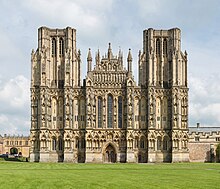Wells Cathedral
| Wells Cathedral | |
|---|---|
| Cathedral Church of St Andrew | |

West Front of Wells Cathedral
|
|
| 51°12′37″N 2°38′37″W / 51.2104°N 2.6437°WCoordinates: 51°12′37″N 2°38′37″W / 51.2104°N 2.6437°W | |
| Location | Wells, Somerset |
| Country | England |
| Denomination | Church of England |
| Website | wellscathedral |
| Architecture | |
| Heritage designation | Grade I listed building |
| Designated | 12 November 1953 |
| Style | Gothic (Early English) |
| Years built | 1176–1490 |
| Specifications | |
| Length | 126.5 m (415 ft) |
| Width | 20 m (66 ft) |
| Width across transepts | 47 m (154 ft) |
| Nave height | 20.5 m (67 ft) |
| Number of towers | 3 |
| Tower height | 55 m (180 ft) (crossing) |
| Administration | |
| Diocese | Bath and Wells (since c. 909) |
| Province | Canterbury |
| Clergy | |
| Bishop(s) | Peter Hancock |
| Dean | John Clarke |
| Precentor | Nicholas Jepson-Biddle |
| Chancellor | Andrew Featherstone |
| Canon Treasurer | Graham Dodds (since 2010) |
| Archdeacon | Nicola Sullivan, Archdeacon of Wells (since 2007) |
| Laity | |
| Organist(s) | Matthew Owens |
The Cathedral Church of Saint Andrew, commonly known as Wells Cathedral, is an Anglican cathedral in Wells, Somerset. The cathedral, dedicated to St Andrew the Apostle, is the seat of the Bishop of Bath and Wells. It is the mother church of the diocese and contains the bishop's throne (cathedra). It was built between 1175 and 1490, replacing an earlier church built on the same site in 705. It is moderately sized among the medieval cathedrals of England, between those of massive proportion such as Lincoln and York and the smaller cathedrals in Oxford and Carlisle. With its broad west front and large central tower, it is the dominant feature of its small cathedral city and a landmark in the Somerset countryside. Wells has been described as "unquestionably one of the most beautiful" and as "the most poetic" of English cathedrals.
The cathedral's architecture presents a harmonious whole which is entirely Gothic and mostly in the Early English style of the late 12th and early 13th centuries. In this respect Wells differs from most other English medieval cathedrals, which have parts in the earlier Romanesque style introduced to Britain by the Normans in the 11th century.
Work commenced in about 1175 at the east end with the building of the choir. The historian John Harvey considers it to be the first truly Gothic structure in Europe, having broken from the last constraints of Romanesque. The stonework of its pointed arcades and fluted piers is enriched by the complexity of pronounced mouldings and the vitality of its carved capitals in a foliate style known as "stiff leaf". Its exterior has an Early English façade displaying more than 300 sculpted figures, described by Harvey as "the supreme triumph of the combined plastic arts in England". The east end retains much ancient stained glass, which is rare in England.
...
Wikipedia
